九年级英语二单元.docx
- 格式:docx
- 大小:107.72 KB
- 文档页数:12
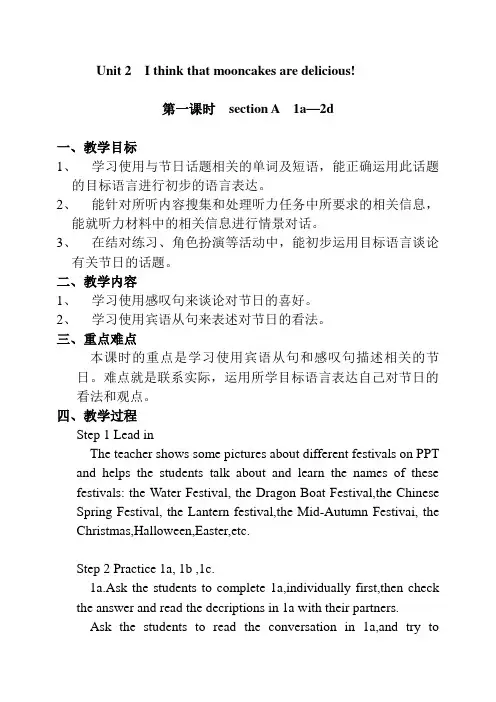
Unit 2 I think that mooncakes are delicious!第一课时section A 1a—2d一、教学目标1、学习使用与节日话题相关的单词及短语,能正确运用此话题的目标语言进行初步的语言表达。
2、能针对所听内容搜集和处理听力任务中所要求的相关信息,能就听力材料中的相关信息进行情景对话。
3、在结对练习、角色扮演等活动中,能初步运用目标语言谈论有关节日的话题。
二、教学内容1、学习使用感叹句来谈论对节日的喜好。
2、学习使用宾语从句来表述对节日的看法。
三、重点难点本课时的重点是学习使用宾语从句和感叹句描述相关的节日。
难点就是联系实际,运用所学目标语言表达自己对节日的看法和观点。
四、教学过程Step 1 Lead inThe teacher shows some pictures about different festivals on PPT and helps the students talk about and learn the names of these festivals: the Water Festival, the Dragon Boat Festival,the Chinese Spring Festival, the Lantern festival,the Mid-Autumn Festivai, the Christmas,Halloween,Easter,etc.Step 2 Practice 1a, 1b ,1c.1a.Ask the students to complete 1a,individually first,then check the answer and read the decriptions in 1a with their partners.Ask the students to read the conversation in 1a,and try todescribe pictures a-d in pairs present their conversations to the class.1b Ask the students to read the sentences in 1b,then play the recording for the the students to listen and circle T for true or F for false.1c The teacher asks two students or read the conversation in 1c to the class.Then ask the students to make other conversations to talk about the festivals in 1a.After that, some pairs should be asked to present their conversations to the class.Step 3 Listening 2a 2b1.Ask the students to look though the sentences in 2a. Make surethey can understand the meaning of each sentence. Then ask the students to listen to the conversation between Wu Ming and Harry and circle the correct words in the sentences.2.Wu Ming did a lot of fun activities, but these also have domnsides. Then ask the students to listen and fill in the chart individually. Check the answers.Step 4 2cAsk two or three pairs to read the model conversation to the class. Then let the students do the pair work to make up their own conversations, using the information in 2a and 2b. Then let some pairs present their conversations to the class.Step 5 Role-play 2dThe students read the conversation and then check their answers together.1. Play the recording for the students to listen and repeat. Ask them to play more attention to the pronunciation and intonation.2. Let the students read the conversation in pairs and find out someuseful expressions and language points in their groups.Step 6 HomeworkPlease choose one of them as your homework.1. listen to the tapes and read after the tapes of 1b,2a 2b,2d forthree times and try to remember the new words and expressions.2. Try to wrete a short passage about Wu Ming’s vacation,according to the information in 2a and 2b.教学反思;第二课时Section A3a—4c一、教学目标1、能就节日这一话题与同伴进行交流与对话,进一步学习话题词汇、句型,了解更多与此话题相关的信息。
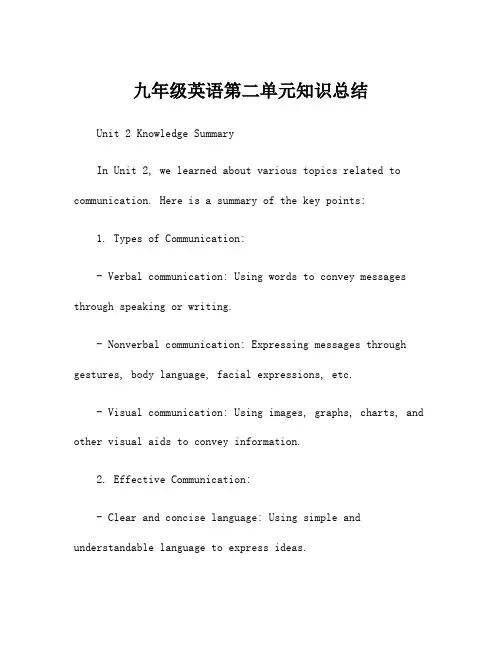
九年级英语第二单元知识总结Unit 2 Knowledge SummaryIn Unit 2, we learned about various topics related to communication. Here is a summary of the key points:1. Types of Communication:- Verbal communication: Using words to convey messages through speaking or writing.- Nonverbal communication: Expressing messages through gestures, body language, facial expressions, etc.- Visual communication: Using images, graphs, charts, and other visual aids to convey information.2. Effective Communication:- Clear and concise language: Using simple and understandable language to express ideas.- Active listening: Paying full attention to the speaker and providing feedback.- Respectful communication: Being polite and considerate towards others when expressing opinions.- Nonverbal cues: Understanding and responding to the body language and gestures of others.3. Communication Skills:- Speaking skills: Being able to express ideas clearly, using appropriate tone and volume.- Writing skills: Communicating effectively through written texts, considering the target audience.- Presentation skills: Delivering information or ideas confidently and engagingly in front of an audience.- Teamwork skills: Collaborating with others, contributing ideas, and actively participating in group discussions.4. Technologies and Communication:- Digital communication: Using electronic devices and platforms such as email, social media, and video calls to communicate.- Advantages and disadvantages of technology: Increased accessibility and efficiency but potential for misunderstandings and reduced face-to-face interactions.5. Cultural Communication:- Understanding cultural differences: Being aware of cultural norms, values, and customs when communicating with people from different backgrounds.- Respect and tolerance: Valuing diversity and avoiding stereotypes or prejudices in communication.6. Conflict Resolution:- Active listening: Understanding the concerns and viewpoints of others in a conflict.- Effective negotiation: Finding compromises and solutions that satisfy everyone involved.- Respectful communication: Expressing opinions without being aggressive or disrespectful.Remembering these communication concepts and skills can help us become better communicators and build stronger relationships with others.。
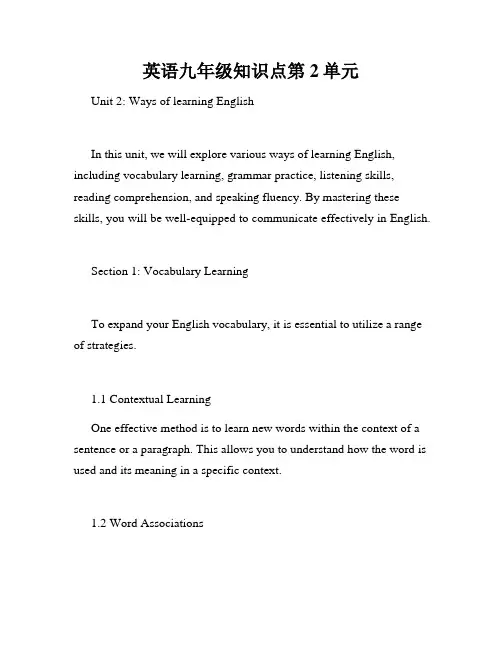
英语九年级知识点第2单元Unit 2: Ways of learning EnglishIn this unit, we will explore various ways of learning English, including vocabulary learning, grammar practice, listening skills, reading comprehension, and speaking fluency. By mastering these skills, you will be well-equipped to communicate effectively in English.Section 1: Vocabulary LearningTo expand your English vocabulary, it is essential to utilize a range of strategies.1.1 Contextual LearningOne effective method is to learn new words within the context of a sentence or a paragraph. This allows you to understand how the word is used and its meaning in a specific context.1.2 Word AssociationsAnother technique is to create word associations by linking new words with words or images that you already know. This mnemonic device can help you remember new vocabulary more easily.1.3 FlashcardsFlashcards are a classic tool for vocabulary learning. Write the target word on one side and its definition on the other. Reviewing flashcards regularly will reinforce your memory.Section 2: Grammar PracticeBuilding a solid foundation in English grammar is crucial for effective communication.2.1 Parts of SpeechUnderstanding the different parts of speech, such as nouns, verbs, adjectives, adverbs, and prepositions, will help you construct grammatically correct sentences.2.2 Verb TensesMastering verb tenses, including present, past, and future tenses, as well as their continuous and perfect forms, allows you to express actions accurately in various time frames.2.3 Sentence StructureLearning about sentence structures, such as subject-verb-object (SVO), subject-verb-complement (SVC), and subject-verb-adverbial (SVA), enables you to construct clear and concise sentences.Section 3: Listening SkillsDeveloping listening skills is vital for effective communication and comprehension.3.1 Active ListeningActive listening involves focusing your attention on the speaker, asking questions for clarification, and summarizing the main points. This helps improve your understanding of spoken English.3.2 Authentic Listening MaterialsListening to authentic materials, such as podcasts, songs, and television shows, exposes you to various accents and real-life speech patterns. This helps you become accustomed to different nuances in the language.Section 4: Reading ComprehensionImproving your reading comprehension skills is essential for understanding written English.4.1 Skimming and ScanningSkimming and scanning are techniques that allow you to quickly locate key information in a text. Skimming gives you an overview, while scanning helps you find specific details.4.2 Vocabulary in ContextAs with vocabulary learning, understanding words in context is crucial for effective reading comprehension. It allows you to grasp the meaning of unfamiliar words based on the surrounding text.Section 5: Speaking FluencyDeveloping speaking fluency is the ultimate goal of language learning.5.1 PronunciationPractice proper pronunciation by focusing on individual sounds, stress patterns, and intonation. This will help you speak clearly and be understood by others.5.2 Role-play and ConversationsEngage in role-play activities and conversations to improve your spoken English. This allows you to practice using appropriate vocabulary and grammar in real-world scenarios.In conclusion, by incorporating these various ways of learning English into your study routine, you can enhance your vocabulary, improve your grammar, strengthen your listening skills, enhance your reading comprehension, and develop your speaking fluency. Remember to practice regularly and stay motivated, and you will make significant progress in mastering the English language.。

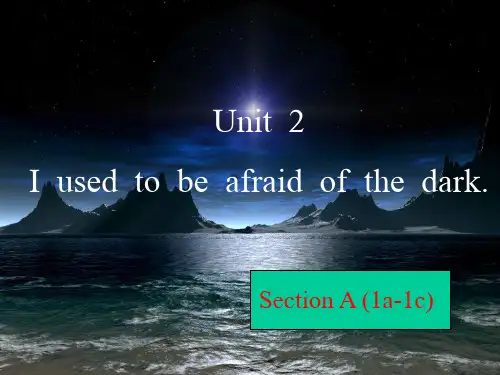
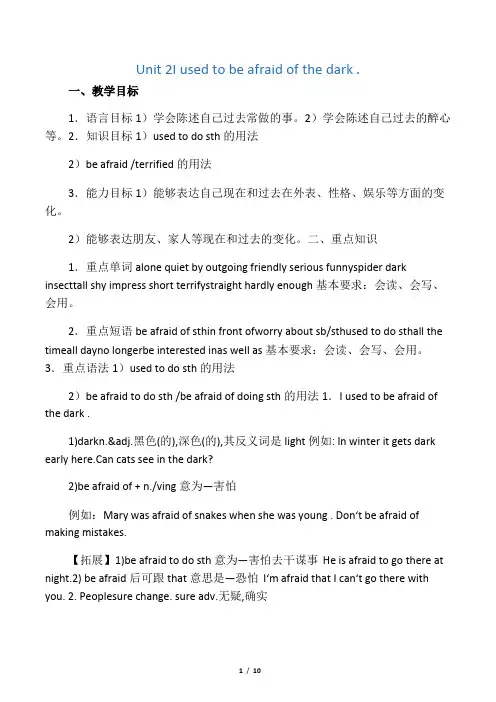
Unit 2I used to be afraid of the dark .一、教学目标1.语言目标1)学会陈述自己过去常做的事。
2)学会陈述自己过去的醉心等。
2.知识目标1)used to do sth的用法2)be afraid /terrified的用法3.能力目标1)能够表达自己现在和过去在外表、性格、娱乐等方面的变化。
2)能够表达朋友、家人等现在和过去的变化。
二、重点知识1.重点单词alone quiet by outgoing friendly serious funnyspider dark insecttall shy impress short terrifystraight hardly enough基本要求:会读、会写、会用。
2.重点短语be afraid of sthin front ofworry about sb/sthused to do sthall the timeall dayno longerbe interested inas well as基本要求:会读、会写、会用。
3.重点语法1)used to do sth的用法2)be afraid to do sth /be afraid of doing sth的用法1.I used to be afraid of the dark .1)darkn.&adj.黑色(的),深色(的),其反义词是light例如: In winter it gets dark early here.Can cats see in the dark?2)be afraid of + n./ving意为―害怕‖例如:Mary was afraid of snakes when she was young . Don‘t be afraid of making mistakes.【拓展】1)be afraid to do sth意为―害怕去干谋事‖He is afraid to go there at night.2) be afraid后可跟that意思是―恐怕‖I‘m afraid that I can‘t go there with you. 2. Peoplesure change. sure adv.无疑,确实【拓展】1)sureadj.确信的,有把握的besuretodosth/that一定干谋事be sure of sth /doing sth干谋事有把握,有信心例如:He is sure to come on time . It is surethat he will come on time.He is sure of passing the exam.=He is sure that he will pass the exam . 2) makesure确保,弄清楚,弄明白Make sure that you get home before dark. 3. terrify v.使害怕,使恐惧其后接宾语,常构成词组be terrified of意为―恐惧……‖例如:The animals were terrifiedby the storm . I was terrified of the tiger when I first saw it. 4. But now I‘m more interested insports。
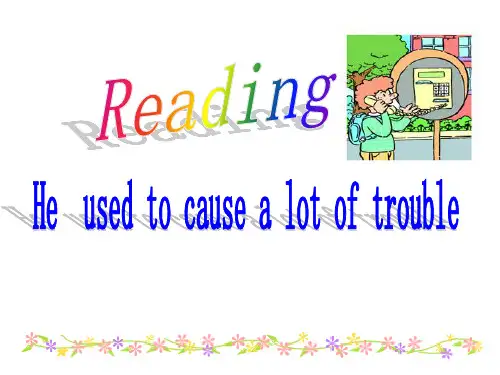
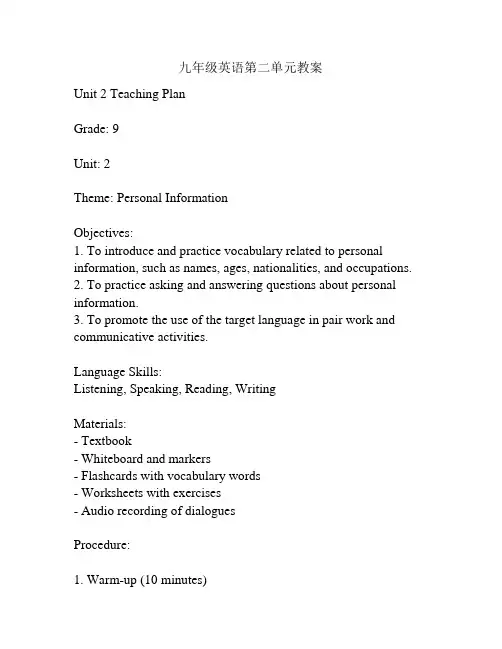
九年级英语第二单元教案Unit 2 Teaching PlanGrade: 9Unit: 2Theme: Personal InformationObjectives:1. To introduce and practice vocabulary related to personal information, such as names, ages, nationalities, and occupations.2. To practice asking and answering questions about personal information.3. To promote the use of the target language in pair work and communicative activities.Language Skills:Listening, Speaking, Reading, WritingMaterials:- Textbook- Whiteboard and markers- Flashcards with vocabulary words- Worksheets with exercises- Audio recording of dialoguesProcedure:1. Warm-up (10 minutes)- Greet the students and engage in a short conversation to create a positive classroom atmosphere.- Review vocabulary related to personal information by showing flashcards and eliciting the correct word from students.- Play a vocabulary game, where students take turns stating personal information about themselves using the vocabulary words. The next student must repeat the previous information and add their own.2. Presentation (15 minutes)- Present the new vocabulary words by showing flashcards and pronouncing them clearly. Drill pronunciation and meaning.- Write the words on the board and provide the students with definitions or example sentences to aid understanding.- Model and practice asking and answering questions about personal information using the vocabulary words.3. Listening (15 minutes)- Play an audio recording of several dialogues between native English speakers discussing their personal information.- Give students a worksheet with multiple-choice questions related to the dialogues. Play the recording again and have students answer the questions.4. Speaking (20 minutes)- Divide the class into pairs. Distribute a role-play activity worksheet to each pair.- Instruct students to practice the role-play with their partner, using the language and vocabulary from the unit.- Monitor the pairs and provide guidance and feedback as needed.- Have a few pairs perform their role-plays in front of the class. 5. Reading and Writing (20 minutes)- Distribute a reading passage about famous people to each student. Instruct them to read the passage individually and underline any personal information mentioned.- As a class, discuss the personal information found in the passage. Have students share their observations and opinions.- In pairs or individually, have students write a short paragraph about their favorite famous person, including their personal information and reasons for admiring them.6. Wrap-up (10 minutes)- Review the vocabulary and language structures introduced in the lesson.- Have students reflect on what they have learned during the lesson and ask for any questions or clarifications.- Assign homework that reinforces the target language, such as completing a worksheet or practicing dialogue scripts.7. Extension Activity (optional, depending on available time)- Play a game of "Guess Who?" where students take turns describing a famous person without mentioning their name. The other students must guess who they are talking about based on the personal information provided.Note: The time allocation for each section is approximate and can be adjusted based on the class dynamics and progress.。
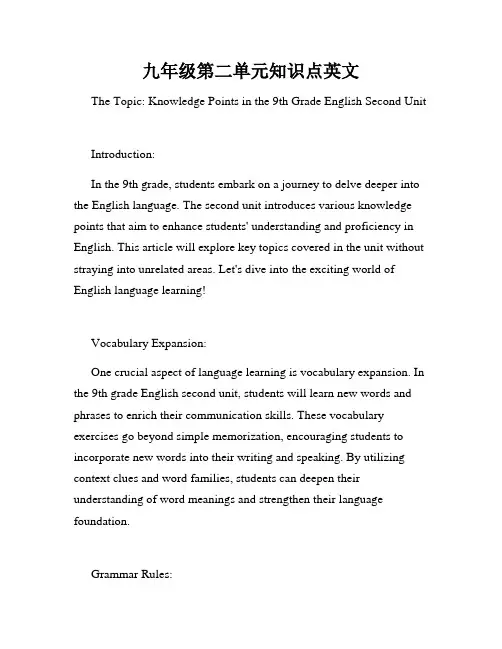
九年级第二单元知识点英文The Topic: Knowledge Points in the 9th Grade English Second UnitIntroduction:In the 9th grade, students embark on a journey to delve deeper into the English language. The second unit introduces various knowledge points that aim to enhance students' understanding and proficiency in English. This article will explore key topics covered in the unit without straying into unrelated areas. Let's dive into the exciting world of English language learning!Vocabulary Expansion:One crucial aspect of language learning is vocabulary expansion. In the 9th grade English second unit, students will learn new words and phrases to enrich their communication skills. These vocabulary exercises go beyond simple memorization, encouraging students to incorporate new words into their writing and speaking. By utilizing context clues and word families, students can deepen their understanding of word meanings and strengthen their language foundation.Grammar Rules:Grammar serves as the backbone of any language, and a strong grasp of English grammar is paramount. The second unit emphasizes several grammar points, including verb tenses, sentence structures, and subject-verb agreement. Through grammar exercises and interactive activities, students will understand the mechanics of forming correct sentences and expressing ideas accurately. Solidifying these grammar rules serves as a stepping stone for effective communication in both spoken and written English.Reading Comprehension:The ability to comprehend written text is vital for students' overall language development. In the 9th grade English second unit, reading comprehension activities are designed to sharpen students' understanding and analytical skills. Exploring various text genres, such as fiction, non-fiction, and poetry, students learn how to identify main ideas, infer information, and draw conclusions. Engaging with diverse texts also broadens students' worldview and nurtures their critical thinking abilities.Writing Skills:Effective writing transcends meticulous grammar and rich vocabulary. In this unit, students will be exposed to various writing formats, including essays, letters, and narratives. Students will learn thefundamentals of structuring paragraphs, organizing their thoughts, and developing coherent arguments. Moreover, they will be encouraged to express their ideas creatively, fostering their individual writing style. Through constructive feedback and revision, students will refine their writing skills, making strides towards becoming proficient English writers.Listening and Speaking:Language learning is incomplete without honing listening and speaking skills. The second unit devotes ample time to improving these essential components of communication. Through listening exercises, students will enhance their ability to understand both native and non-native accents. Various speaking activities, such as role plays and presentations, encourage students to express themselves confidently and fluently. These interactive tasks foster teamwork, critical thinking, and creativity among students.Conclusion:The 9th grade English second unit encompasses a comprehensive range of knowledge points that elevate students' language proficiency. From vocabulary expansion and grammar rules to reading comprehension and writing skills, every aspect of language learning is thoughtfully incorporated. By delving into these topics, students gainthe tools and confidence to navigate the English language successfully. Ultimately, the second unit prepares students for further language advancement and equips them with valuable skills for future endeavors.。
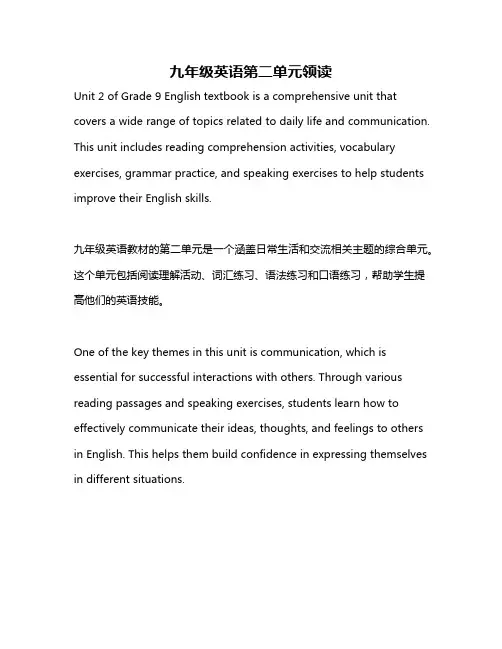
九年级英语第二单元领读Unit 2 of Grade 9 English textbook is a comprehensive unit that covers a wide range of topics related to daily life and communication. This unit includes reading comprehension activities, vocabulary exercises, grammar practice, and speaking exercises to help students improve their English skills.九年级英语教材的第二单元是一个涵盖日常生活和交流相关主题的综合单元。
这个单元包括阅读理解活动、词汇练习、语法练习和口语练习,帮助学生提高他们的英语技能。
One of the key themes in this unit is communication, which is essential for successful interactions with others. Through various reading passages and speaking exercises, students learn how to effectively communicate their ideas, thoughts, and feelings to others in English. This helps them build confidence in expressing themselves in different situations.这个单元的一个重要主题是交流,这对于成功地与他人互动至关重要。
通过各种阅读材料和口语练习,学生们学会如何有效地用英语传达他们的想法、思想和感受给别人。
九年级二单元英语知识要点 1 .Chinese Spring Festival 春节 2. The Lantern Festival 元宵节
3.the Mid-Autumn Festival 中秋节 4.The Water Festival 泼水节
5.The Dragon Boat Festival 端午节 6. a little too crowded 有一点太拥挤 be crowded with 被。。挤满
7. wonder v.想知道 8.wonder n.惊奇,奇迹・ wonderful adj. no wonder 难怪,怪不得 the wonders of the world 世界奇观
wonder about想知道;对…感到奇怪;考虑
wonder at对…感到惊讶/奇怪
in wonder 在惊奇【11 no wonder 难怪,怪不得 with wonder 惊奇地 the wonders of the world 世界奇 观
There was a look of wonder in his eyes.他眼屮露出惊奇的神色。
They were filled with wonder at the new waterfall.他们对新瀑布感到非常惊奇。
I wonder I don*t know ...这两个短语都可译成"不知道"。其区别是:
1 wonder…作“不知道”解时,其中含冇“想知道”的意思;I don't know只是用來陈述对某事“不知道”
这一事实。例如: I wonder what you call this.不知道你们把这个叫做什么。
…Do you know what they call this?你知道他们把这个叫做什么吗?一 I don*t know.我不知道。
I wonder _____ he will come before 9:00 p.m.. A. what B. that C. when D. if 9. 1 love the races.I think that they're ftin to watch have ftin to do sth be fun to do sth 10. go for vacation 去度假 go on vacation 在度假
11. put on five pounds增加5傍put on穿上;上演;增加;
What dress shall I put on for the meeting?我穿什么衣服去开会?
He didn't want to put on more weight.他不想增加体重。
The local drama group are putting on “ Sister Jiang v at the Capital Theatre.
当地的剧团止在首都剧场演出《江姐》。你喜欢端午节的哪些方面? take ofI7 put off/ put down / put out/ put up with 忍受,容忍/ put away 12. 【自主归纳】
短语put on有不同的含义,其常见含义如下: 13. in two weeks在这句话里的意思是“两周之后”。
He'll be back in two weeks. 他两周后回来。 “in+ —段时间”和将来时连用,表示“在某段时间之后”。
(2010 汕J北省卷)This term ____ over. The summer vacation is coming in two weeks. A. is B. was C. has been D. will be 【解析】句义为“这学期即将结束,暑假在两星期Z后就要到来。”,故选择D。 “in+—段时间”和将来时连用,表示“在某段时间内”
I will finish my homework in 2 hours. 我两小时内做完了功课。after + 一段时间用于一般过去时14.. Sounds like fun.听起来很冇趣。省略T it这个形式主语,完整的句子是:It sounds like fun. sound like 听
起来像 It sound like a nice room. Can we take a look at it? 听起來房间不错,我们能看一看房间吗?Their love story sounds like a fairy tale. 他们的爱情故事 听起来像童话。 感官动词+ like feel like摸起來像 smell like闻起來像
look like看起来像taste like尝起来像
15. be similar to 跟...类似的;与...同样的同义词the same as be similar to的反义短语是be different from…(与 .... 不同)
16. throw water at each other 朝彼此泼水
throw-at 朝。。仍 / throw., to 扔给某人/throw away 扔掉
Throw me that dictionary.把那本词典扔给我。
He threw the ball to another player.他把球传给另一个队员
。
17. in the shape of lit ...形状 18.…is the most touching 19. touching adj. 动人的;感人的/ touched This is the most touching story I have ever heard.这是我听到过的最动人的故事。
We were deeply touched by their presents.我们被他们的礼物深深感动。
touch v.触摸;感动;触及;接触
Don't touch the paint until it's dry.油漆未干,切勿触摸。
His sad story touched our hearts.他的悲惨的故事深深打动了我们的心。
20. shoot down 击落,射下。-shot shoot at 朝。。射击
21. Whoever drank this could live forever, ••• whoever pron.无论是谁; 任何人。
Whoever wants the book may have it.谁想要这本书都可以拿。
Fll take whoever wants to go. 谁要去我就带谁去。
whoever= no matter who whatever=no matter what whenever=no matter when---.. 22. steal v.偷;窃取 / stole- stolen steal••- from***. rob sb of sth抢走某人某物/ robbed 23. 辨析:steal / rob从意思上讲steal表示偷窃的意思,而rob表
示抢劫的意思;从搭配上來讲,steal sth. from sb. / sth.;而rob则用rob sb. / sth. of sth.o例如: He stole money from the rich to give it to the poor.
24. refuse to do sth拒绝做某事light, n.光,日光,vt.使发光;点燃;adj.轻的;少量的,浅色的。
fly - flew- flown 25. call out one* s name.大叫某人的名字o layout摆开;布置
Don't lay out your clothes on the bed. Put them away. 别把你的衣服都摊在床上,把它们收起來
26. lay v.放置;=place 安放;产(卵);卜(蛋)-laid-laid You may lay it on the table.你可以把它放在桌子上。
You can't expect the hen to lay in the afternoon. 你不能期望鸡下午生蛋 °
lie- lied-lied 说谎lie-lay-lain 躺卜,位于;处于…
27. lay, place, put, set这些动词均有“放” Z意。
lay指小心地把人或物平放或横放,侧重动作安稳。 place较正式用词,指把某物放在一个止确的位S±,侧重动作的正确。
put普通用词,含义较广泛。指把人或物置于某处,并将其留在该处。
set普通用词,指为了某种目的而将人或物放在一定位置上。指物时多指立着放。
28. admire v.欣赏;仰慕He was very successful in his business and all his friends admired him.他的事业非常成功,他的刖友都很 羡
慕。admire sb/sth., admire sb. for sth.。 We admire (him for) what he has done.我们对他所做的事很钦佩。
[2012 江苏无锡】一 Jason is too stubborn sometimes. 一 I quite _______ . But he*s always friendly to others. A. accept B. argue C. agree D. admire 我很钦佩我父母亲。
29. dress up 打扮;穿上盛装Dress up常与as, in连用构成短语:
dress up as...意为"装扮/乔装打扮成…” dress up in...意为“穿上…”后接表示衣服或 颜色的名词。 ► He likes to dress up as a soldier.他喜欢装扮成午:人。
辨析:dress, wear, put on, have on 与 be in Dress “给某人穿衣服”,其宾语是人或反身代词,不是表示衣服等的名诃
Wear “穿着;戴着”强调状态Put on “穿上;戴着”强调动作
Have on “穿着;戴着”强调状态。不能用于被动语态。
Be in “穿着;戴着”强调状态,通常接表示颜色的名词。
30. treat n. 款待;招待 she was cooking fish as a treat.
她正在做鱼来款待客人。This is my treat. 这次由我做东 play a trick on意为"捉弄” treat with sb跟某人商谈